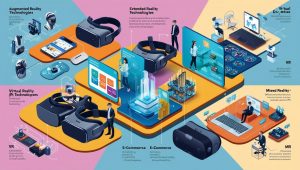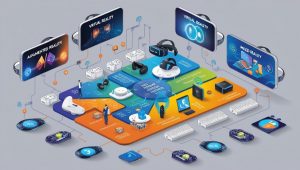The extended reality (XR) market in North America is rapidly evolving, shaping the future of immersive technologies that blur the lines between the physical and digital worlds. XR encompasses virtual reality (VR), augmented reality (AR), and mixed reality (MR), creating new ways for users to interact with digital content in real-time. As businesses, consumers, and industries embrace the potential of XR, North America is becoming a hub for technological advancements that are transforming a range of sectors, from gaming and entertainment to healthcare, education, and manufacturing.

Key Drivers Behind the Growth of XR in North America
1. Technological Advancements in VR, AR, and MR
At the heart of the extended reality boom in North America is the rapid development of VR, AR, and MR technologies. Advances in hardware, such as more powerful headsets, better sensors, and lower latency, have made immersive experiences more seamless and accessible. Software innovations, including AI-powered content and enhanced motion tracking, are further driving user engagement. The convergence of these technologies is transforming user experiences across multiple platforms, enabling immersive environments that feel as real as the physical world.
2. Widespread Adoption Across Industries
The XR market in North America is benefiting from widespread adoption across various industries. Gaming remains a dominant use case, with VR and AR offering an unparalleled level of immersion for players. As gaming companies and tech giants invest heavily in XR hardware and software, the gaming ecosystem is evolving into a more interactive and participatory space. In addition, sectors like healthcare, education, and real estate are capitalizing on XR technology to enhance their offerings:
-
Healthcare: XR is being leveraged for surgical training, medical visualization, and patient rehabilitation. Virtual simulations allow medical professionals to practice complex surgeries in a risk-free environment, improving their skills and reducing errors in real-world scenarios. In therapy, AR and VR are helping patients with pain management and mental health treatment.
-
Education: Virtual and augmented reality are transforming traditional learning environments. XR enables hands-on experiences, such as historical tours, immersive science experiments, or complex engineering projects, offering students a more interactive and engaging way to learn. AR-based textbooks and apps are also allowing students to interact with content in real-time, enhancing retention and understanding.
-
Manufacturing & Automotive: In the industrial sector, MR and AR are used for remote support, training simulations, and design visualization. Manufacturing plants are using XR to enhance factory efficiency, while automotive companies are using virtual reality for virtual prototyping and design reviews, reducing costs and improving product quality.
Download PDF Brochure @
https://www.marketsandmarkets.com/pdfdownloadNew.asp?id=147143592
3. Growth in Consumer Applications
Consumers are increasingly becoming aware of the potential of XR technologies, thanks to the proliferation of AR-enabled smartphones, wearable devices, and VR headsets. The consumer electronics market is set to see exponential growth, with more accessible and affordable XR devices entering the market. For instance, Apple, Microsoft, and Google are investing heavily in AR and VR technologies, with Apple’s AR glasses, Microsoft’s HoloLens, and Google’s ARCore platform all contributing to the rise of AR experiences in consumer products.
With the ongoing development of XR-based applications in sectors like retail, real estate, and tourism, customers can expect to interact with products and services in ways that were once limited to sci-fi movies. From virtual shopping experiences and property tours to immersive entertainment, XR is enabling more engaging consumer experiences.
4. Government and Private Sector Investment
The continued growth of the extended reality market in North America is being fueled by significant investments from both the public and private sectors. Venture capital firms and major technology companies are pouring resources into XR development, with a focus on creating the next generation of immersive experiences. Additionally, government initiatives are supporting extended reality through grants and funding programs, particularly for research and development.
For instance, the U.S. Department of Defense has invested in XR technologies for defense and training applications. Similarly, government-led initiatives aimed at improving the educational and healthcare sectors are also pushing forward XR adoption. This combination of public and private investments has created a fertile ecosystem for innovation.

Key Challenges to Overcome
Despite the growing momentum in the extended reality space, North America’s extended reality market faces certain challenges that need to be addressed for continued growth. The primary obstacle remains the cost of hardware. High-end VR headsets, AR glasses, and motion sensors are still expensive, limiting widespread adoption among consumers. However, as technology advances and manufacturing scales, costs are expected to decrease over time.
Another challenge is the lack of standardized frameworks for extended reality content and applications. As different players enter the market, interoperability between hardware and software remains a significant issue. Industry players are working on developing open standards and more robust ecosystems to overcome this hurdle.
Future Outlook
The future of the North American extended reality industry looks promising, with projections indicating rapid growth in the coming years. The XR market is expected to continue expanding, driven by technological innovation, consumer demand, and industry adoption across a wide range of sectors.
Key areas of focus include:
-
5G Connectivity: The rollout of 5G networks is expected to revolutionize XR applications by providing the high-speed, low-latency connectivity necessary for seamless augmented and virtual reality experiences.
-
Artificial Intelligence Integration: AI will continue to enhance XR capabilities by enabling smarter, more adaptive systems that can learn and respond to user behavior in real-time. This could lead to more personalized and immersive experiences.
-
Enterprise Solutions: As industries like manufacturing, healthcare, and retail increasingly adopt XR for business purposes, we will see more enterprise-specific solutions emerge, from virtual training platforms to product visualization tools.
North America’s extended reality market is at the forefront of a revolution in how we interact with digital content. By combining cutting-edge technologies like VR, AR, and MR, the region is shaping the future of immersive experiences across a broad spectrum of industries. As technological advancements continue and applications expand, the market is set for substantial growth, providing innovative solutions to businesses, consumers, and industries alike.
With the growing demand for interactive and immersive experiences, North America is positioned to lead the way in the evolution of the extended reality industry. As the technology matures and becomes more accessible, the potential applications of XR are limitless, making it a market to watch closely in the coming years.
FAQ: North America Extended Reality Market
1. What is Extended Reality (XR)?
Extended Reality (XR) is an umbrella term that encompasses Virtual Reality (VR), Augmented Reality (AR), and Mixed Reality (MR). These technologies create immersive digital environments that either replace or enhance the real world, allowing users to interact with content in new and innovative ways.
2. How is the North American XR market evolving?
The North American XR market is expanding rapidly, driven by technological advancements in VR, AR, and MR hardware and software. Significant investments from both private sector companies and government initiatives are accelerating growth, with applications emerging in industries like gaming, healthcare, education, retail, and manufacturing.
3. What are the key drivers of growth in the North American XR market?
-
Technological advancements: More powerful, affordable, and seamless VR, AR, and MR devices.
-
Industry adoption: Widespread use in gaming, healthcare, education, manufacturing, and retail.
-
Consumer demand: Increased consumer interest in immersive experiences through AR-enabled devices and VR headsets.
-
Investments: Heavy investments from both the government and private companies in XR research, development, and infrastructure.
4. How is XR used in healthcare?
In healthcare, XR technologies like VR and AR are used for medical training, surgical simulations, pain management, and mental health treatments. XR enables doctors and medical students to practice procedures in a controlled, virtual environment, while also providing patients with therapeutic treatments using immersive experiences.
5. What is the role of XR in education?
XR in education enhances learning experiences by creating immersive environments where students can interact with complex concepts and experiments. Virtual field trips, 3D models, and simulations provide hands-on experiences that make learning more engaging and effective.
6. How will 5G impact the XR market?
The rollout of 5G networks will significantly impact the XR market by providing the high-speed, low-latency connections necessary for seamless XR experiences. 5G will make cloud-based XR applications faster and more efficient, reducing lag and improving the overall quality of virtual and augmented environments.
